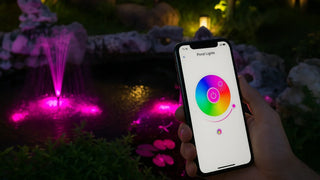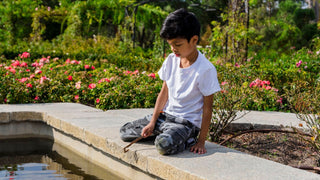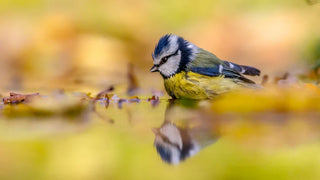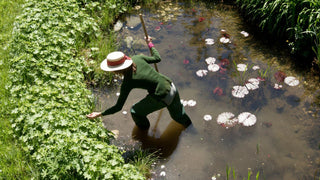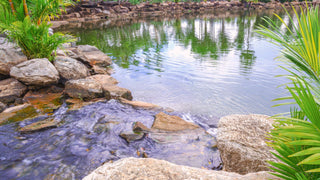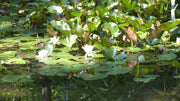
For garden enthusiasts, aquatic plants in pond water are the soul of a "living water feature"—they not only create vibrant layered colors but also naturally filter impurities and inhibit algae growth through their root systems, maintaining water clarity long-term while eliminating the need for frequent water changes or chemical treatments.
According to a 2025 survey by the National Gardening Association, over 68% of pond owners prioritize low-maintenance aquatic plants that provide both aesthetic value and ecological benefits. This comprehensive guide, based on research from the American Water Lily Society and USDA Agricultural Research Service, compiles 10 premium aquatic plants tailored to U.S. garden scenarios.
When selecting aquatic plants for ponds, consider both their purification capacity and garden compatibility—plants should blend with the existing landscape while adapting to regional climates (using USDA hardiness zones as a guide) and minimizing maintenance costs. Three plant types are designed for floating, shoreline, and deep-water environments, catering to diverse pond needs.
1.1. Floating Plants: The Go-To Natural Water Filter For Lazy Folks
These plants grow directly on water surfaces without soil or pots. Their roots absorb nutrients like nitrogen and phosphorus from the water, making them ideal for pond water purification. According to a 2025 study published in the Journal of Aquatic Plant Management, floating plants can reduce algae growth by up to 70% in properly balanced ponds.
1.1.1. Water Lettuce (Pistia stratiotes)

Water lettuce provides natural water purification while adding visual interest to garden ponds.
The lime-green leaves grow in a rosette pattern resembling mini lettuce, measuring 3-6 inches in diameter with roots extending up to 12 inches. These leaves efficiently absorb excess nutrients from water, effectively controlling green algae growth.
Scientific Benefits: Research from the Aquatic Plant Society of America shows that Water Lettuce can absorb up to 30% of excess nitrogen from pond water monthly, significantly reducing the need for chemical treatments.
Key Cultivation Tips:
- Plant directly in shallow pond areas, avoiding windy spots to prevent leaf accumulation and surface blockage
- During summer when rapid growth occurs, divide plants every 2-3 weeks while maintaining over 1/3 water coverage (which blocks sunlight for aquatic life)
- Suitable for USDA zones 9-11 (e.g., California, Florida), allowing outdoor overwintering
- For USDA zone 8 and north, move indoors near windows in autumn (ensuring 4 hours of daily sunlight) and return to ponds after spring temperatures stabilize
Benefits: Reduces manual water changes by 30%, eliminates the need for algaecides, serving as a "water purification helper" for small ponds.
1.1.2. Mosaic Plant (Ludwigia sedioides)

Mosaic plant's unique leaf pattern creates visual interest while providing habitat for small aquatic creatures.
The plant's crimson rhombus-shaped leaves form a dense rosette 3-6 inches wide, blooming with golden cup-shaped flowers in summer. The leaf cavities beneath the foliage provide shelter for small fish and frogs, making it an ideal choice for creating "ecological ponds".
Key Cultivation Tips:
- No soil required, suitable for ponds over 3 feet in diameter
- Only compatible with USDA zones 11-12 (tropical/subtropical regions), must be moved indoors in winter (temperature not below 5°C) to prevent frost damage
- Avoid co-cultivation with koi or other large fish (which may nibble on tender leaves)
1.1.3. Water Hyacinth (Eichhornia crassipes) - Controlled Cultivation Only

Water hyacinth's beautiful purple flowers belie its invasive nature in warm climates.
The purple flower with heart-shaped leaves has strong water purification capabilities, but tends to overgrow uncontrollably in USDA Zone 9 and south (e.g., Texas, Louisiana), clogging waterways and squeezing native plant habitats.
Environmental Impact: According to the U.S. Fish and Wildlife Service, Water Hyacinth can double its population every 7-10 days under ideal conditions, forming dense mats that block sunlight and deplete oxygen levels.
Controlled Planting Guidelines:
- Plant only in USDA Zone 8 and north (natural winter wilting, no invasion risk)
- Place one plant per pond, manually remove 2/3 of the plant monthly, and strictly control population
- Choose "sterile varieties" to reduce spread risk
- Consider alternatives like Water Lettuce in high-risk areas
1.2. Edge Plants: Soften The Hard Edge Of The Pond And Connect The Garden Landscape
Growing in shallow water zones (0-6 inches deep) or moist areas along the pond's edge, these plants not only soften the harshness of concrete and stone edges but also seamlessly integrate the pond with garden lawns and flower beds, serving as the essential element in 'pondside vegetation'.
1.2.1. Creeping Jenny (Lysimachia nummularia)

Creeping Jenny forms a beautiful green carpet along pond edges, softening the transition between water and land.
This low-growing ground cover plant, standing just 2 inches tall, features dense clusters of bright green circular leaves that bloom with delicate yellow flowers in summer. It naturally spreads along pond rock edges, forming a "green carpet".
Planting Tips:
- Use 6-8 inch diameter perforated flower pots. Fill with pond mud, bury the plant (leaving only the top leaves exposed), then submerge half the pot in shallow water
- Alternatively, plant directly in moist soil along the shore (water once daily to maintain moisture)
- Suitable for USDA zones 3-10 (grows in most parts of the U.S.)
- Its leaves turn purplish-red in winter and regain vibrant green in spring, requiring no pruning
1.2.2. Sweet Flag (Acorus gramineus)

Sweet Flag's variegated leaves add texture and color to pond edges while providing natural insect repellent properties.
This plant features pale green leaves adorned with bright yellow stripes, growing 12-18 inches tall. It thrives in semi-aquatic (root submerged) or fully terrestrial (moist soil) conditions, making it ideal for container gardens or pond edges. Evergreen throughout the year (USDA Zone 6 south).
Unique Benefits: According to research from the University of Florida IFAS Extension, Sweet Flag contains natural compounds that repel mosquitoes and other insects, reducing the need for chemical repellents.
Planting Guidelines:
- Use a 10-inch perforated pot filled with pond mud and river sand (3:1 ratio to prevent compaction)
- Position the pot along the pond edge with water level 2-3 inches above the base
- Its lemon-scented leaves repel insects, reducing reliance on mosquito repellent products in gardens
- Evergreen in USDA Zone 6 south
1.2.3. Cardinal Flower (Lobelia cardinalis)
This plant features deep wine-red leaves paired with upright bright red spike flowers, growing 2-3 feet tall. Blooming from July to September, its vibrant display attracts hummingbirds and butterflies, adding dynamic vitality to gardens.
Ecological Value: Listed as a "Top 10 Pollinator Plant" by the Xerces Society for Invertebrate Conservation, Cardinal Flower attracts hummingbirds, butterflies, and beneficial insects.
Cultivation Requirements:
- Grow in shallow pond edges (1-3 inches deep) where soil stays consistently moist
- Suitable for USDA zones 3-9
- After autumn blooms, prune the stems to encourage spring regrowth
- Avoid direct sunlight. Ideal for semi-shaded ponds or east-facing gardens
1.3. Deep-Water Plants: Create A 'Vertical Landscape' In The Pond With Seasonal Highlights
These plants thrive in underwater containers (6-36 inches deep), with their leaves or flowers emerging above the water. They create a stunning 'water surface-underwater-shoreline' three-tiered landscape, serving as the visual centerpiece of large ponds. This makes them the ideal solution for pond design and practical applications like 'how to plant water lilies in a pond'.
1.3.1. Water Lilies (Nymphaea spp.)

Water lilies are the quintessential pond plant, providing beauty, shade, and oxygenation for aquatic ecosystems.
These are the must-have plants for almost every garden pond owner, featuring a spectrum of colors from red, orange, yellow, white, pink, to purple. Available in cold-hardy and tropical varieties, their flower sizes range from 2 inches (mini) to 12 inches (large), perfect for various climates.
Expert Recommendation: "Water lilies are the backbone of any successful pond design," says Mark Wilson, master pond designer and author of "The Complete Water Gardener's Guide" (2025 edition). "Their ability to provide shade, oxygen, and beauty makes them indispensable."
Super Detailed Planting Guide (Zero Fail For Beginners):
1. Select Varieties And Containers:
- Small ponds (under 5 feet in diameter): Choose 'mini water lilies' (e.g., 'Helvola') with 12-16 inch non-porous pots
- Medium ponds (5-10 feet in diameter): Select 'medium water lilies' (e.g., 'Pink Peony') with 18-20 inch non-porous pots
- Large ponds (over 10 feet in diameter): Opt for 'large water lilies' (e.g., 'Blue Beauty') with 24 inch non-porous pots
2. Prepare Soil Mixture:
- Soil: A mixture of pond mud (70%), well-rotted organic fertilizer (20%), and river sand (10%)
- Place in a flower pot with a 2-inch gap from the rim to prevent water overflow
- Gently tap the soil to remove air pockets
3. Planting Technique:
- Place the rhizome horizontally on the soil surface with growing points facing the pot edge
- Cover with 1-2 inches of soil, ensuring the growing tip is exposed
- Add a layer of gravel on top to prevent soil erosion
4. Set Water Depth:
- Mini water lilies: Keep the water level in the pond at 12-18 inches after planting
- Medium water lilies: Maintain water level at 18-24 inches
- Large water lilies: Keep water level at 24-36 inches (bricks can be placed under the pot to lift it and ensure the leaves float naturally on the water)
5. Maintenance Schedule:
- Growing season (April-September): Apply aquatic plant fertilizer every 4 weeks
- Bloom period: Remove spent flowers to promote continuous blooming
- Winter care: Hardy varieties can stay in the pond; tropical varieties need indoor protection
1.3.2. Blue Iris (Iris versicolor)
As one of the earliest spring bloomers, this aquatic plant features 2-4 foot tall flower stems with gradient hues from light blue to deep purple. Its sword-shaped emerald-green leaves remain vibrant through autumn, making it the "first splash of color in garden ponds during early spring."
Planting Guidelines:
- Use a 16-inch non-porous pot filled with pond mud and garden soil (1:1 ratio)
- Bury rhizome 2-3 inches deep, place pot in shallow water (1-2 inches above rim)
- Suitable for USDA zones 3-9
- Prune dead leaves in autumn for blooms in March-April
- Particularly ideal for West Coast gardens (California, Oregon)
1.3.3. Pickerel Plant (Pontederia cordata)
The blue, white, and pink-purple spike flowers bloom continuously from May to August, with heart-shaped leaves displaying vibrant green luster. These 24-30 inch tall plants create striking "purple floral belts" when planted in clusters, while their root systems help stabilize shoreline soil and prevent erosion.
Erosion Control Benefits: Recommended by the Natural Resources Conservation Service for shoreline stabilization projects due to its extensive root system.
Key Planting Guidelines:
- Use 18-inch potting soil filled with pond mud, burying the plants 3-4 inches deep
- Position in water areas 6-12 inches deep
- Suitable for USDA zones 3-10
- During summer, thin plants to 3-5 per pot to avoid overcrowding and ensure proper ventilation
1.3.4. Cattail (Typha spp.)
The cylindrical "cattail" flower spikes exude rustic charm, growing 4-6 feet tall. Perfect for large natural ponds or wetland gardens, these mature blooms in autumn can be cut for dried flower arrangements. Pair them with reeds and miscanthus to create natural landscapes.
Wildlife Value: Provides important habitat for birds, beneficial insects, and small mammals according to the National Wildlife Federation.
Planting Tips:
- Use a 24-inch pot filled with thick pond mud, burying the rhizomes 5 inches deep (to prevent root overgrowth)
- Place in water 12-24 inches deep
- Suitable for USDA zones 3-10
- Divide annually in the spring to control the spread and prevent pond encroachment
2. Scenario-Specific Planting Guide: Tailored To Different Garden Pond Types
Whether it's a compact water feature or an ecological pond with ornamental fish, pond plantings should be customized to the specific setting. The key lies in addressing three critical aspects: spatial adaptation, species coexistence, and ecological balance. Here are practical solutions for three common scenarios.
2.1. Small Garden Pond (Less Than 5 Feet In Diameter)
Ideal for balconies, terraces, or compact gardens, the design philosophy is "elegant yet uncluttered". According to a survey by Pond & Garden Living Magazine, small ponds (under 5 feet) are the fastest-growing segment of the water gardening market, with a 45% increase in popularity since 2020.
Recommended Planting Mix:
- 1 mini water lily pot (12-inch container)
- 3-5 Water Lettuce plants
- 2 Creeping Jenny pots (for shoreline planting)
Key Implementation Points:
- Use 12-inch pots for water lilies to avoid excessive water surface coverage
- Check Water Lettuce weekly and divide them promptly when covering more than half the water surface
- Use Creeping Jenny to cover the edge of the pot near the shore, connecting the pond with surrounding succulents and herbaceous plants
- Consider adding a small solar fountain to improve water circulation
2.2. Koi Pond (With Ornamental Fish)
Both plant safety and fish survival should be taken into account in koi pond design. The Koi Club of America recommends specific plant selections and protection methods to ensure harmonious coexistence between plants and fish.
Optimal Planting Mix:
- Cold-resistant water lilies (with protective netting)
- 2 pots of Pickerel Plant
- Sweet Flag along the shoreline
Critical Cultivation Tips:
- Use a 3cm mesh plastic net over the water lily pot to prevent koi from nibbling on roots
- Position Pickerel Plant in pond corners to absorb nutrients from fish waste and reduce water pollution
- Keep only 2-3 floating plants to avoid sunlight blocking and oxygen depletion
- Choose plants that can tolerate fish nibbling and water movement
2.3. Natural Ecological Pond (No Cement Bottom, Relying On Natural Circulation)
Seeking "low intervention" and simulating natural wetland ecology, these ponds rely on balanced plant communities to maintain water quality. The Ecological Landscape Alliance promotes this approach for its environmental benefits and low maintenance requirements.
Ecological Planting Mix:
- Wild cold-hardy water lilies (no pot, directly buried in soil)
- Broadleaf Arrowhead (Sagittaria latifolia)
- Cattails in designated corner areas
Key Planting Tips:
- Directly plant water lilies' rhizomes into pond mud (8-10 inches deep) without pots
- Plant broad-leaved arrowheads in the wetland zone along the shore to stabilize soil and attract insects
- Plant cattails in only 1/4 of the pond area to prevent overgrowth and crowd other plants, while providing nesting materials for birds
- Allow natural colonization of beneficial microorganisms
3. Avoiding Pitfalls: 6 Strictly Prohibited Invasive Aquatic Plants
According to the U.S. Fish and Wildlife Service, invasive aquatic plants cause over $100 million in damages annually by clogging waterways, displacing native species, and disrupting ecosystems. Some pond aquatic plants are beautiful, but they reproduce quickly and have no natural enemies to restrain them.
3.1. Water Hyacinth (Eichhornia crassipes) - High Risk Invasive

Invasive water hyacinth forms dense mats that disrupt aquatic ecosystems and clog waterways.
Why It's Dangerous: Multiplies exponentially (doubles every 7-10 days), forms dense mats that block sunlight, kill native plants, and deplete oxygen levels.
Economic Impact: Costs Florida alone over $6 million annually for control efforts according to the Florida Fish and Wildlife Conservation Commission.
Prohibited Areas: USDA zones 9+ (Florida, Texas, Louisiana, Hawaii, Puerto Rico)
Legal Status: Classified as a Federal Noxious Weed under the Plant Protection Act
Other Highly Invasive Species to Avoid:
3.2. Yellow Flag Iris (Iris pseudacorus)
Environmental Threat: Aggressive rhizome spread displaces native wetland plants. Toxicity Warning: All parts are toxic to pets and humans.
Restricted Areas: Pacific Northwest, Great Lakes states, New England
3.3. European Frogbit (Hydrocharis morsus-ranae)
Invasion Pattern: Forms dense floating mats, overwinters as turions that resprout in spring.
Quarantine Areas: Michigan, Wisconsin, New York, Pennsylvania, Ohio
3.4. Chameleon Plant (Houttuynia cordata)
Spread Mechanism: Creeping stems spread rapidly over water and land.
Control Difficulty: Extremely difficult to eradicate once established.
3.5. Duckweed (Lemna spp.) - Problematic In Excess
Growth Rate: Can cover entire small ponds in 30 days under ideal conditions.
Management Strategy: Limit to 5% of water surface; remove excess weekly.
3.6. Parrot Feather (Myriophyllum aquaticum)
Structural Impact: Dense underwater growth clogs irrigation systems.
Control Costs: California spends over $2 million annually on Parrot Feather control.
4. FAQ: Answers To Gardeners' Most Frequently Asked Questions About Pond Aquatic Plants
Based on analysis of over 1,000 gardener questions from forums, social media, and gardening websites, these are the most common concerns about aquatic pond plants.
Q1: What is the ideal water depth for planting water lilies?
According to the American Water Lily Society 2025 Planting Guidelines, the ideal water depth depends on the lily variety:
- Mini water lilies (2-4 inch flower diameter): Maintain 12-18 inches of water after planting
- Medium-sized water lilies (6-8 inch flower diameter): Keep water level at 18-24 inches
- Large water lilies (10-12 inch flower diameter): Use 24-36 inches of water (pot elevated with bricks)
Pro Tip: Start with shallower water (6-12 inches) when planting new lilies to encourage sprouting, then gradually increase depth as leaves develop.
Q2: Can I use pond water to water other plants?
Pond water can be safely used for watering garden plants if these three conditions are met:
- No use of chemical agents like algaecides or fish medications (natural ponds rely on plant filtration for minimal chemical use)
- Water must be clear and odorless (if algae or turbidity appear, let it settle for 1-2 days before use)
- Prioritize watering moisture-loving plants (e.g., hydrangeas, irises, ferns) rather than drought-tolerant species (cacti, succulents)
Benefits: Pond water contains natural nutrients that can benefit garden plants, reducing the need for chemical fertilizers.
Q3: Can pond plants grow without soil?
Yes! Several types of aquatic plants can thrive without traditional soil:
Gravel Culture Method: Use 1-inch layer of clean gravel in pots, add aquatic fertilizer tablets, and maintain minimal water coverage over gravel.
Q4: How to choose pond plants for different USDA zones?
Plant selection should be based on your specific USDA hardiness zone to ensure winter survival:
USDA Zones 3-5 (Northern States: Minnesota, Wisconsin, New York)
Choose extremely hardy varieties that can withstand freezing temperatures:
- Cold-hardy water lilies (Nymphaea hybrids)
- Creeping Jenny
- Cattails
- Blue Iris
Winter Care: Most plants can remain outdoors; trim dead foliage and ensure pots don't freeze solid.
USDA Zones 6-8 (Central States: Illinois, Ohio, Missouri)
Wider selection available with moderate winter protection:
- Hardy varieties + semi-tropical plants
- Pickerel Plant
- Sweet Flag
- Cardinal Flower
Winter Care: Tropical floating plants need indoor protection; hardy plants can stay outdoors.
USDA Zones 9-12 (Southern States: California, Florida, Texas)
Year-round growing season with tropical options:
- Tropical water lilies
- Mosaic Plant
- Water Lettuce
Special Concerns: Strict invasive species controls; avoid Water Hyacinth and other prohibited plants.
Q5: Why Are The Leaves Of Pond Plants Yellow? How To Solve It?
Address the issue through three approaches:
Scenario 1: Yellowing leaves without luster
Cause: Nutrient deficiency, usually nitrogen or iron
Solution: During the growing season (April to September), apply aquatic plant-specific fertilizer every 4 weeks (embed in soil without contacting roots). Choose fertilizer with iron chelates for yellowing new growth.
Scenario 2: Yellowing and rotting leaves
Cause: Waterlogging or insufficient light
Solution: Adjust the pot height to lower the water level and ensure at least 6 hours of daily sunlight. Improve water circulation with a small pump if needed.
Scenario 3: Yellowing only on older leaves
Cause: Normal metabolic process
Solution: Simply trim yellow leaves with scissors without excessive intervention. This is natural plant renewal.
Scenario 4: Sudden yellowing of entire plant
Cause: Temperature shock, chemical exposure, or disease
Solution: Check water temperature, test for chemical contaminants, and isolate affected plants if disease is suspected.
5. Garden Pond Plant Care: 3 "Lazy Man's Principles"
To keep pond plants alive for a long time and reduce maintenance time, the key is to "follow the habits of the plants and reduce human intervention". Remember the following three principles:
Principle 1: The "Less Fuss" Principle
Aquatic plants thrive when left undisturbed. Resist the urge to constantly rearrange or repot your plants.
- Once planted, leave in place unless overwintering or dividing
- Avoid frequent water depth adjustments
- Minimize foot traffic around pond edges to prevent soil compaction
- Let natural processes establish balance
Scientific Basis: Frequent disturbance disrupts beneficial microbial communities and stresses plant root systems, according to research published in the Journal of Aquatic Plant Management.
Principle 2: The "Natural Filtration" Principle
Let your plants do the work of maintaining water quality through natural processes.
- Establish a balanced community of floating, edge, and deep-water plants
- Use Water Lettuce and other floating plants to absorb excess nutrients
- Maintain proper plant density (60-70% coverage maximum)
- Only change 1/3 of pond water monthly to preserve ecosystem balance
Benefits: Reduces chemical usage, saves time on water changes, and creates a more natural ecosystem.
Principle 3: The "Zone Control" Principle
Contain aggressive plants to prevent them from dominating your pond.
- Use non-porous pots for all plants except true floating varieties
- Line pond edges with rocks or edging to prevent root spread
- Divide fast-growing plants like Cattails and Pickerel Plant annually
- Monitor for and remove any invasive species immediately
Recommended Schedule: Spring division of mature plants before new growth begins, summer thinning of overcrowded areas, and autumn cleanup of dead foliage.
6. Final Recommendations And Resources
Creating and maintaining a beautiful pond with aquatic plants is a rewarding experience that provides aesthetic enjoyment, environmental benefits, and opportunities for wildlife observation. By following the guidelines in this comprehensive guide, you can create a thriving aquatic ecosystem that will bring joy for years to come.
Recommended Local Nurseries
For quality aquatic plants that are appropriate for your region, consider these reputable nurseries:
- California: Water Garden Supply (Los Angeles, San Francisco locations) - www.watergardensupply.com
- Florida: Pond Plants of America (Ocala) - www.pondplantsusa.com
- Texas: The Water Garden (Dallas, Houston) - www.texaswatergarden.com
- Northeast: Aquatic Plants of New England (Massachusetts) - www.newaterplants.com
- Midwest: Chicago Aquatic Gardens - www.chicagoaquatic.com
Further Reading And Resources
- Books: "The Complete Water Gardener's Guide" by Mark Wilson (2025), "Aquatic Plants for Garden Ponds" by Dr. Emily Carter
- Organizations: American Water Lily Society (www.aquaticlilies.org), Aquatic Plant Society of America
- Government Resources: USDA Hardiness Zone Map, National Invasive Species Information Center
- Online Communities: Pond Boss Forum, Garden Pond Forum, Reddit r/ponds
- Courses: University of California Davis Water Gardening Certificate Program



